
Bellis perennis, the daisy, is a common European species of the family Asteraceae, often considered the archetypal species of that name. To distinguish this species from other "daisies" it is sometimes qualified as common daisy, lawn daisy or English daisy. Historically, it has also been widely known as bruisewort, and occasionally woundwort.

Lomatium is a genus of about 75 species of perennial herbs native to western North America; its common names include biscuitroot, Indian parsley, and desert parsley. It is in the family Apiaceae and therefore related to many familiar edible species such as carrots and celery; some Lomatium species are extensively used by Native Americans in the inland Northwest as a staple food.
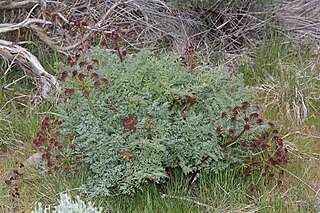
Lomatium dissectum is a species of flowering plant in the carrot family known by the common name fernleaf biscuitroot. It is native to much of western North America, where it grows in varied habitat. It is found in the eastern slopes of the Cascade Range, Rocky Mountains, Klamath Mountains, eastern Transverse Ranges and the Sierra Nevada in California.
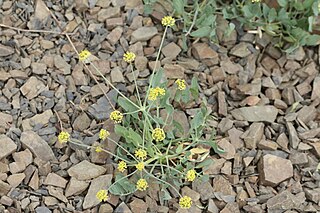
Lomatium nudicaule is a species of flowering plant in the carrot family known by the common names pestle lomatium, barestem biscuitroot, Indian celery and Indian consumption plant. It is native to western North America from British Columbia to California to Utah, where it is known from several habitat types, including forest and woodland. It is a perennial herb growing up to about 70 centimeters tall from a thick taproot. It generally lacks a stem, the inflorescence and leaves emerging from ground level. The leaves are made up of many dull green, waxy lance-shaped leaflets each up to 9 centimeters long. The inflorescence is borne on a stout peduncle widening at the top where it blooms in an umbel of yellow or purplish flowers.

Lomatium utriculatum is a species of flowering plant in the carrot family known by the common name common lomatium or spring gold. It is native to western North America from British Columbia to California, where it grows in many types of habitat including chaparral, and in the Sierra Nevada.
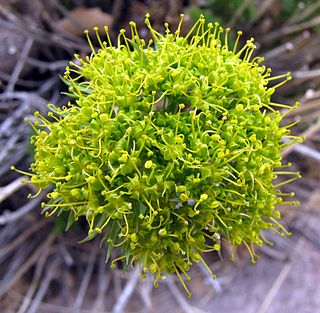
Lomatium parryi, commonly known as Parry's biscuitroot and Utah desertparsley, is a perennial herb in the carrot family. It is a common herb in high altitude areas of deserts and common in desert National parks, such as Death Valley mountains, in the western part of the United States.
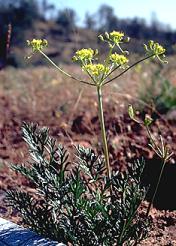
Lomatium congdonii, known by the common names Mariposa desertparsley and Congdon's lomatium, is a species of flowering plant in the carrot family.

Lomatium grayi, commonly known as Gray's biscuitroot, Gray's desert parsley, or pungent desert parsley, is a perennial herb of the family Apiaceae. It is native to Western Canada in British Columbia, and the Western United States, including from the Eastern Cascades and northeastern California to the Rocky Mountains.

Lomatium suksdorfii is a perennial herb of the family Apiaceae that grows in Washington and Oregon, United States.
Lomatium ciliolatum is a species of flowering plant in the carrot family known by the common name Yolla Bolly biscuitroot. It is endemic to California, where it is known from the mountain ranges adjacent to the north and south of the San Francisco Bay Area, at 300–600 feet, 1200–2100 m. It is often a member of the serpentine soils flora in woodland and chaparral habitat.

Lomatium howellii is an uncommon species of flowering plant in the carrot family known by the common name Howell's biscuitroot, or Howell's lomatium. It is native to the Klamath Mountains of southern Oregon and northern California, where it is a member of the local serpentine soils flora.
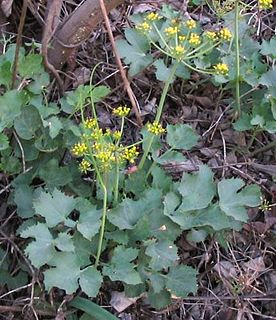
Lomatium lucidum is a species of flowering plant in the carrot family known by the common name shiny biscuitroot. It is native to coastal mountains and canyons of southern California and Baja California, where it is a member of the chaparral plant community, including recently burned areas. It is found in the eastern Transverse Ranges and the South Coast region.
Lomatium marginatum is a species of flowering plant in the carrot family known by the common name butte desertparsley. It is endemic to California, where it is known from mountains, valley, and grassland habitat, including serpentine, in the northern half of the state. It is a perennial herb growing up to about half a meter tall from a small taproot. There is no stem, and the leaves and inflorescence emerge from ground level. The purple-green leaves may approach 30 centimeters long, their blades divided into many long, narrow segments. The short but wide inflorescence bears an umbel of yellowish, purplish, or reddish flowers. The Lomatium marginatum is not currently an endangered species.

Lomatium martindalei is a species of flowering plant in the carrot family known by the common names Cascade desertparsley and coast range lomatium. It is native to the west coast of North America, from Vancouver Island south to the Klamath Mountains of far northern California. It can be found in a number of coastal and inland habitats, from coastal plains to high mountain talus and meadows. This is a perennial herb growing 15 to 40 centimeters tall from a carrot-like taproot. There is often no stem, the erect or spreading leaves and inflorescence emerging from ground level. The thinly fleshy leaves may approach 20 centimeters long, their blades divided into leaflets made up of many small oval segments. The inflorescence bears an umbel of small yellowish flowers.

Lomatium nevadense is a species of flowering plant in the carrot family known by the common name Nevada biscuitroot. It is native to the western United States and northern Mexico, where it is known from several different habitat types, including sagebrush and woodlands. It is a perennial herb growing up to about 45 centimeters tall from a taproot. The leaves are up to about 16 centimeters long, their blades divided into many oblong pointed segments. The inflorescence is an umbel of white or cream flowers.
Lomatium repostum is an uncommon species of flowering plant in the carrot family known by the common name Napa biscuitroot, or Napa lomatium. It is endemic to California, where it is known only from the northrthern California Coast Ranges surrounding the northern San Francisco Bay Area. It often grows in plant communities on serpentine soils.

Lomatium stebbinsii, known by the common name Stebbins' desertparsley, is a rare species of flowering plant in the carrot family.

Lomatium tracyi is a species of flowering plant in the carrot family known by the common name Tracy's desertparsley, or Tracy's lomatium. It is native to the mountains of northern California and southern Oregon, where it grows in the forests on the slopes, often on serpentine soils. It is a perennial herb growing up to 35 centimeters tall from a slender taproot. There is generally no stem, the leaves and inflorescence emerging at ground level. The leaf blades are divided and subdivided into a mass of overlapping threadlike to oval segments. The inflorescence is an umbel of yellow flowers.

Lomatium triternatum is a species of flowering plant in the carrot family known by the common name nineleaf biscuitroot. It is native to western North America from British Columbia to California to Colorado, where it grows in many types of habitat. It is a hairy perennial herb growing up to a meter tall from a taproot. The leaves emerge from the lower part of the stem. Each is generally divided into three leaflets which are each subdivided into three linear leaflike segments. The inflorescence is an umbel of yellow flowers, each cluster on a ray up to 10 centimeters long.
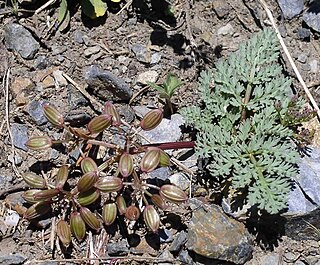
Lomatium erythrocarpum, known by the common name redfruit desertparsley, is a rare species of flowering plant in the carrot family. It is endemic to Oregon in the United States, where it is limited to a section of the Blue Mountains within Baker County.
















